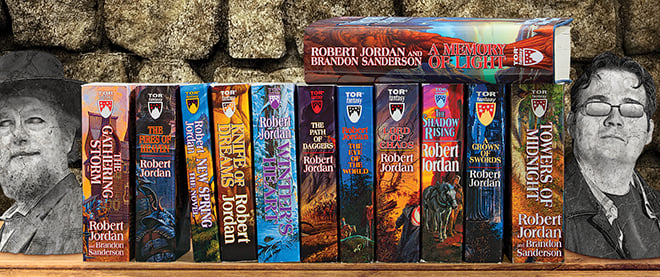The Wheel of Time: A 23-year cliffhanger comes to a close
Through 14 books and the death of author Robert Jordan, fans of a cult series hung on
Photo Illustration by Sarah Mackinnon
Share

The appeal of serial stories is all in the delayed satisfaction. It’s about waiting the whole summer to find out who shot J.R., or three years to see if Han Solo would make it out of the carbonite. It’s about cliffhangers and the blissful agony of wondering what’s next. But for fans of The Wheel of Time—a massively popular series of fantasy novels that debuted in 1990 and recently came to an end—it must have felt at times that the payoff would never come.
Set in an imaginary world of squabbling kingdoms, magic and swordplay, The Wheel of Time set a new standard for delayed gratification. Originally intended to be a handful of books, the series eventually stretched to 14, spread across 23 years, with more than 2,000 characters and nearly 12,000 pages. For a time, fans—who number in the millions and rival Trekkies for their fervour—wondered if it would ever end. In 1996, with eight books and nearly 17 years still to come, a writer in the New York Times joked that “humankind may well reach its promised apocalypse before Mr. Jordan’s characters do.”
The human race did survive to see the conclusion of The Wheel of Time. But its creator, Robert Jordan, did not. He died in 2007 with only 11 books written. Brandon Sanderson, a young fantasy writer, was brought in to finish the series, and fans stayed loyal. In January, Sanderson released A Memory of Light, the final book. Like the titles before it, it debuted at number 1 on every major book chart in the U.S. To date, the entire series has sold at least 25 million copies in North America alone, according to Tor, its publisher. With international sales rolled in, that makes it quite possibly the most popular series of adult fantasy books since The Lord of the Rings.
But sales numbers only go partway toward describing the frenzy it has created. Jamie Broadhurst—vice-president of marketing at Raincoast, A Memory of Light’s Canadian distributor—compares the fan fanaticism for the series to that of the Harry Potter books, in intensity if not in pure numbers. At a recent Wheel of Time event Raincoast put on in Vancouver, fans drove from as far away as Edmonton, through the Rocky Mountains in February, to attend.
Some fans credit the series for shaping their adult selves. “I’ve been reading these books for a lifetime,” says Jennifer Liang, who started when she was 12. She met her future husband in an online forum for Wheel of Time fans. She now organizes an annual conference dedicated to Jordan’s work. This year’s event, to be held this month, has already sold out two hotels in Atlanta, she says.
Even for fans, though, it can be hard to describe what about The Wheel of Time invokes such passion. The books tell the story of Rand al’Thor, a shepherd’s son who discovers he is the reincarnation of the Dragon—a hero from another age born again to save this one. The first several books were fairly typical of the genre. But around the fourth, they started to sprawl out. Major characters would disappear for hundreds of pages, and new ones were constantly introduced. (Sanderson had to tap the fan community to keep all 2,000 straight when he took over the series.)
The writing could be clunky. And the plot advanced at a glacial pace. Jason Denzel, a devotee who founded a web forum for fans, admits even he was confused at times. “You’ve waited all these years, and book 10 finally comes out and nothing happens,” he says. “For a lot of readers, that’s frustrating.” And yet there was something undeniably, almost inexplicably, compelling about the narrative. The story was like an itch that took 23 years to scratch, in a good way.
Thanks largely to HBO’s Game of Thrones, we are enjoying a bit of a fantasy moment. But for all its success, The Wheel of Time remains an underground phenomenon. Maybe that’s because, even as nerd culture has gone mainstream—comics, sci fi and computer culture are all cool now—books about dragons and magic have stayed on the outside. For fans, that may be part of the appeal: not everyone wants to be mainstream; some still want their own worlds. And in literature, there are few as detailed—or as much fun to get lost in—as the one Jordan created.